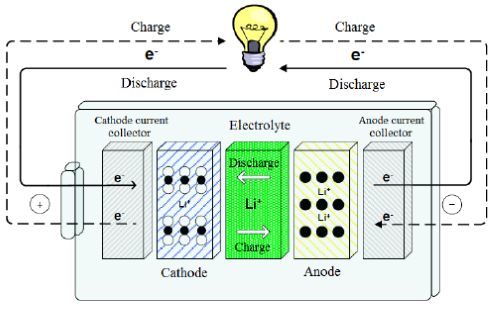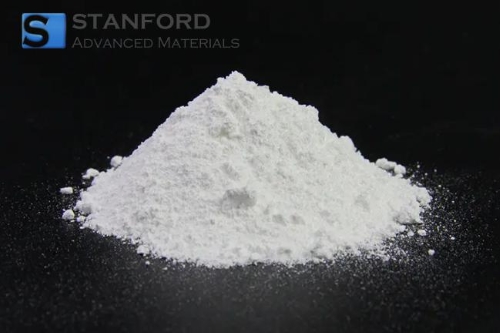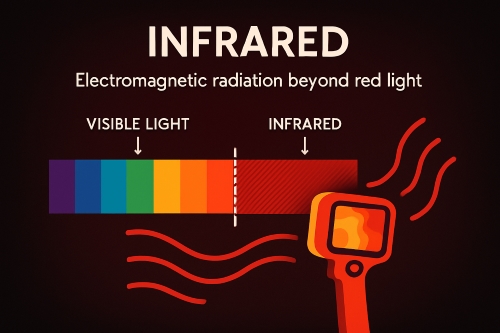Électrolyte solide LATP: Un composant clé pour les batteries à l'état solide
Le LATP (Lithium Lanthanum Titanate Phosphate) s'est imposé comme un matériau clé dans le développement de technologies avancées de stockage de l'énergie, en particulier dans les batteries à l'état solide. Grâce à ses propriétés distinctes, le LATP est devenu un élément central pour les chercheurs et les fabricants qui cherchent à améliorer les performances, la sécurité et l'efficacité des batteries.
Cet article présente les principales caractéristiques, les applications et les concepts essentiels du LATP.
 [1]
[1]
Qu'est-ce que le LATP ?
Le phosphate de lithium-lanthane-titane (LATP) est un composé cristallin qui associe le lithium (Li), le lanthane (La), le titane (Ti) et le phosphate (PO₄) dans une structure stable. La combinaison de ces éléments donne un excellent conducteur ionique, ce qui fait du LATP un candidat idéal pour être utilisé comme électrolyte solide dans les batteries de la prochaine génération.
Contrairement aux électrolytes liquides conventionnels, qui peuvent être inflammables et présenter des risques pour la sécurité, le LATP offre une alternative plus sûre et plus stable avec des caractéristiques de performance supérieures.

Propriétés et avantages clés
L'électrolyte solide LATP possède plusieurs propriétés intéressantes qui en font un matériau intéressant pour les dispositifs de stockage d'énergie :
- Conductivité ionique élevée: Le LATP a démontré une conductivité ionique élevée, un facteur critique pour l'efficacité des batteries à l'état solide. Sa conductivité ionique dépasse souvent 10-⁴ S/cm à température ambiante, ce qui est comparable, voire supérieur, à de nombreux autres électrolytes solides, tels que l'oxynitrure de phosphore de lithium (LiPON).
- Large fenêtre de stabilité électrochimique: L'un des principaux avantages du LATP est sa large fenêtre de stabilité électrochimique, qui améliore la stabilité de la batterie et réduit le risque de réactions indésirables entre l'électrolyte et les électrodes.
- Bonne résistance mécanique: Le LATP est connu pour ses propriétés mécaniques robustes, qui contribuent à garantir l'intégrité structurelle de la batterie, en particulier pendant les cycles de charge et de décharge.
- Sécurité: La nature solide du LATP élimine le risque de fuite et de combustion, qui sont des dangers courants associés aux électrolytes liquides. Les batteries à base de LATP sont donc beaucoup plus sûres, en particulier dans les applications à haute énergie.
- Stabilité thermique: Le LATP reste stable à haute température, ce qui est vital pour les batteries à haute performance qui peuvent fonctionner dans des conditions thermiques variables.
Applications de l'électrolyte solide LATP
Les électrolytes solides LATP sont le plus souvent utilisés dans les batteries à l'état solide (SSB), qui sont considérées comme la prochaine frontière des technologies de stockage de l'énergie. Ces batteries ont le potentiel de surpasser les batteries lithium-ion conventionnelles dans plusieurs domaines clés, notamment la densité énergétique, la vitesse de charge et la sécurité.
- Véhicules électriques (VE): Les batteries à l'état solide avec des électrolytes LATP peuvent permettre une plus grande autonomie et des temps de charge plus rapides que les batteries lithium-ion actuelles. En outre, la sécurité accrue des batteries à l'état solide à base de LATP réduit le risque d'emballement thermique, qui peut être critique dans les applications des véhicules électriques.
- Électronique portable: Les batteries à l'état solide à base de LATP sont étudiées pour être utilisées dans les smartphones, les ordinateurs portables et les appareils portables. Leur densité énergétique plus élevée permet d'utiliser des sources d'énergie plus petites et plus efficaces, ce qui se traduit par des appareils plus légers et plus compacts.
- Stockage en réseau: Les batteries à l'état solide basées sur le LATP ont le potentiel d'améliorer le stockage de l'énergie pour les sources d'énergie renouvelables, telles que le solaire et l'éolien. Ces batteries peuvent offrir une capacité plus élevée et une durée de vie plus longue, ce qui est crucial pour les solutions de stockage d'énergie à grande échelle.
- Dispositifs médicaux: La nature ininflammable et stable du LATP en fait un matériau idéal pour alimenter les appareils médicaux qui nécessitent des batteries fiables et durables. Sa sécurité et sa haute densité énergétique sont particulièrement utiles pour les dispositifs implantables et les capteurs.
LATP et autres électrolytes solides
Le LATP est un électrolyte solide prometteur pour les batteries lithium-ion à l'état solide. Toutefois, il existe d'autres électrolytes solides susceptibles d'être utilisés dans ces batteries, tels que les électrolytes à base de sulfure : le LATP est un électrolyte solide prometteur pour les batteries lithium-ion entièrement solides :
- les électrolytes à base de sulfure: Des matériaux comme le Li2S-P2S5 (sulfure de lithium-pentasulfure de phosphore) offrent une conductivité ionique élevée, souvent supérieure à celle du LATP. Cependant, ils sont sensibles à l'humidité, ce qui peut limiter leur application pratique.
- Électrolytes à base de phosphate: D'autres matériaux phosphatés, tels que Li7La3Zr2O12 (LLZO), présentent une conductivité ionique élevée et sont plus stables dans l'air que les sulfures, ce qui en fait une alternative viable au LATP. Cependant, le LLZO souffre de problèmes liés à la formation de dendrites et à l'instabilité mécanique.
- Électrolytes à base d'oxyde: Les oxydes solides, tels que le Li7La3Zr2O12 (LLZO) de type grenat et les matériaux de type pérovskite, sont robustes et offrent une bonne stabilité électrochimique. Leur conductivité ionique est généralement inférieure à celle du LATP, mais reste acceptable pour les piles à l'état solide.
Chaque type de matériau présente des compromis en matière de conductivité, de stabilité et de compatibilité avec les anodes au lithium.
Conclusion
L'électrolyte solide LATP est un matériau qui change la donne dans le développement des batteries à électrolyte solide. Sa conductivité ionique élevée, sa sécurité et sa stabilité électrochimique en font un excellent choix pour alimenter les appareils de la prochaine génération, des véhicules électriques à l'électronique portable.
Bien qu'il reste des défis à relever, les recherches en cours et les progrès réalisés dans le domaine de la science des matériaux devraient permettre d'exploiter encore davantage le potentiel du LATP dans le secteur du stockage de l'énergie. Alors que les batteries à l'état solide continuent d'évoluer, le LATP devrait jouer un rôle clé dans l'avenir des technologies de stockage de l'énergie durable.
Stanford Advanced Materials (SAM) propose une sélection complète de matériaux céramiques de haute qualité à des prix compétitifs, ce qui nous positionne comme votre partenaire de confiance dans l'industrie des batteries. Notre poudre LATP est un nano-électrolyte solide de pointe, essentiel au développement de batteries lithium-ion à l'état solide.
Une gamme variée de batteries Li-ion et de produits chimiques électroniques, comprenant des solutions d'électrolyte pour batteries, des matériaux pour cathodes et anodes de batteries et des produits chimiques pour l'assemblage électronique, est également disponible. Ces produits sont conçus pour soutenir les progrès en matière de stockage d'énergie, de véhicules électriques et de fabrication électronique. Pour plus d'informations ou pour discuter de vos besoins spécifiques, veuillez consulter notre page d'accueil.
Référence :
[1] Sousa, Rui & Sousa, J. A. & Ribeiro, J. & Goncalves, L.M. & Correia, J.H. (2013). Batteries à l'état solide : An overview for bio applications. 3rd Portuguese Bioengineering Meeting, ENBENG 2013 - Book of Proceedings. 10.1109/ENBENG.2013.6518400.

 Bars
Bars
 Beads & Spheres
Beads & Spheres
 Bolts & Nuts
Bolts & Nuts
 Crucibles
Crucibles
 Discs
Discs
 Fibers & Fabrics
Fibers & Fabrics
 Films
Films
 Flake
Flake
 Foams
Foams
 Foil
Foil
 Granules
Granules
 Honeycombs
Honeycombs
 Ink
Ink
 Laminate
Laminate
 Lumps
Lumps
 Meshes
Meshes
 Metallised Film
Metallised Film
 Plate
Plate
 Powders
Powders
 Rod
Rod
 Sheets
Sheets
 Single Crystals
Single Crystals
 Sputtering Target
Sputtering Target
 Tubes
Tubes
 Washer
Washer
 Wires
Wires
 Converters & Calculators
Converters & Calculators
 Write for Us
Write for Us
 Chin Trento
Chin Trento



